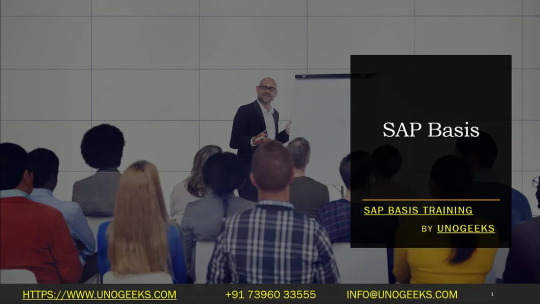#netweaves
Explore tagged Tumblr posts
Text
Configuring SAP PI System & Setting Up NetWeaver Developer Studio
We will walk you through the steps of installing the necessary JDK version and configuring NetWeaver Developer Studio on your local PC in this comprehensive tutorial. We’ll also set up the SAP PI system to work with NWDS. The NWDS program itself will allow us to create, edit, and display the ID and ESR objects once they are defined. read more

#SAPPI#NetWeaver#SAPConfiguration#SAPIntegration#NetWeaverDeveloperStudio#SAPDevelopment#SAPExperts#IntegrationPlatform#EnterpriseIntegration#SAPTechnology
0 notes
Text
Conversas sobre o que é ser netweaver - com o Bing...
. Um dia, há umas duas semanas atrás, resolvi usar o CoPilot do Bing para ter esta conversa abaixo, sobre o que é ser um netweaver. O resultado foi esse: Continue reading Untitled

View On WordPress
0 notes
Text
#sap basis#basis support#sap basis consultants#sap basis consulting#sap netweaver basis#sap systems#sap applications#sap modules
1 note
·
View note
Text
Exploring NetWeaver: A Comprehensive Guide
In this article, we will explain the most important elements of NetWeaver and outline its capabilities, which can help ensure effortless execution. At the end of this article, you’ll have a greater knowledge of the ways NetWeaver can assist you in achieving the highest level of commercial efficiency. Introduction to SAP Net Weaver(NW) Modern companies require seamless systems and software…

View On WordPress
#net weaver#netweaver#netweaver sap#sap net weaver#sap netweaver#sap netweaver portal#sap portal netweaver#what is sap netweaver
1 note
·
View note
Text

Day 6: Be'lal
The envious netweaver.
10 notes
·
View notes
Text
Wheel of Time full series spoiler thoughts on TDR 40-End
A probably semi-regular weekly bonus to my reread blog, since sometimes you realize things on reread that just make you need to yell in a full spoiler space.
"She always had a temper like lightning, but she always had a soft heart, too, for anyone poor or hungry." Well, we can see why Elayne cares so much, if her mother always has, too. But, what could have changed?
Aludra, my queen. Yes, I have a lot of queens in this series, shush. Oh, your matches will light so many fires and still be the least of your accomplishments by the end.
I'm already tired of the falcon-hawk thing, and Faile and Berelain won't even meet this book. Oh boy this is gonna be a fun read.
SAMMY! The second most insecure of all the men who couldn't handle being Brian. (Yes, it's the Pythons' weakest film, but it's a good landmark for comparison since, isn't it basically every male Forsaken that joins the Dark because they weren't as good as LTT?
Rahvin… [disgusted face]
Egg's dreams in chapter 48 are some of the most pointedly accurate so far, once you know the whole tale. Zoinks! The Luhhans being used for bait for Perrin, the axe and the hammer, all the living Forsaken following Rand, Rand getting the Dragon tattoos, the faceoffs between him and Egg in book 13/14, like, DANG.
Comar makes to fight because he's under a Compulsion, like as not. Not like Rahvin would leave anything, even loyalty, to chance. (gagging noises)
Poor Be'lal, The Netweaver, The Envious, and now The Forgotten in the fandom.
Nynaeve's signature move, the right hook, will never not be hilarious.
"Just because I am shielded here does not mean I am shielded in the World of Dreams." It's just a weave. See also: Rand splitting the balefire around himself with Callandor.
At least this time Rand's mostly right about defeating Ishy. He had to be brought back in a new body after this one.
I obviously couldn't put it into the post, but I do find it fascinating how the Arthuriana first seems like "oh, sure, you read a book, well done" and then gets woven into the core of the narrative with the Seanchan and all, and I don't remember the details but I remember a fun little interaction with Berelain at one point about it. Just, so much thought and planning making this series stand the test of time, right alongside all the unplanned/changed elements keeping us on our toes.
#wheel of time#wot#the wheel of time#twot#wot book spoilers#wheel of time full series spoilers#wot full series spoilers
2 notes
·
View notes
Text
SAP Basis

SAP Basis: The Backbone of Your SAP Landscape
SAP applications form the core of many modern enterprises. Financial data, customer interactions, supply chain logistics, and many other critical business operations rely on SAP’s robust solutions. But what powers these solutions? That’s where SAP Basis comes in.
What is SAP Basis?
In simple terms, SAP Basis is the technological foundation upon which SAP applications are built and run. It’s like the operating system specifically for your SAP world. Basis provides a set of middleware components and administration tools that ensure your SAP applications function smoothly and reliably.
Key Responsibilities of an SAP Basis Administrator
SAP Basis administrators are the unsung heroes of the SAP world, responsible for a wide range of tasks:
Installation and Configuration: Basis admins handle the initial installation and setup of SAP systems, ensuring they’re configured correctly for your business needs.
System Administration: They perform ongoing tasks like monitoring system health, applying patches and upgrades, and managing system resources.
Database Management: This includes database installation, configuration, backup and restore processes, and overall database health.
Performance Tuning: Basis admins identify bottlenecks, optimize settings, and ensure applications run at their peak.
User Management: Creating and managing user accounts, assigning roles and authorizations for secure access control.
Troubleshooting: When problems arise, these experts step up to diagnose and resolve issues promptly, minimizing downtime for the business.
Transport Management: They oversee the movement of code changes and configuration updates between different SAP environments (e.g., development, testing, production).
Components of SAP Basis
Some core components that make up SAP Basis include:
SAP NetWeaver: The core technology platform that provides the foundation for different SAP products.
ABAP Workbench: The development environment for creating custom ABAP code (SAP’s primary programming language).
SAP GUI: The graphical user interface used to interact with SAP systems.
Transport Management System: Tools for managing and tracking changes across SAP environments.
Solution Manager: A centralized platform for system monitoring, diagnostics, and support tools.
Why is SAP Basis Important?
Reliability and Stability: A well-managed SAP Basis system means your critical business applications will run smoothly, minimizing disruptions and downtime.
Performance: Basis expertise ensures that your SAP applications are optimized to deliver their best, promoting efficient business operations.
Security: Basis includes a suite of tools to manage user access, protect sensitive data, and ensure compliance with security standards.
Agility: A flexible Basis layer gives your business the ability to adapt to changing needs by scaling SAP deployments or introducing new components.
Becoming an SAP Basis Administrator
A career in SAP Basis is both challenging and rewarding. If you have a knack for technical troubleshooting, problem-solving, and enjoy working with complex systems, here’s how to get started:
Get a Technical Foundation: A background in computer science, database administration, or system administration is a strong starting point.
Gain SAP Expertise: Take SAP Basis training courses and explore online resources and tutorials.
Certifications: Consider getting SAP-certified in Basis administration to validate your skills.
Hands-on Experience: Look for internship or entry-level positions that allow you to work on real SAP systems.
The Future of SAP Basis
As SAP continues to evolve into a cloud-centric platform, Basis will adapt too. Knowledge of cloud technologies, containerization, and automation will become increasingly valuable for Basis administrators.
youtube
You can find more information about SAP BASIS in this SAP BASIS Link
Conclusion:
Unogeeks is the №1 IT Training Institute for SAP BASIS Training. Anyone Disagree? Please drop in a comment
You can check out our other latest blogs on SAP BASIS here — SAP BASIS Blogs
You can check out our Best In Class SAP BASIS Details here — SAP BASIS Training
Follow & Connect with us:
— — — — — — — — — — — -
For Training inquiries:
Call/Whatsapp: +91 73960 33555
Mail us at: [email protected]
Our Website ➜ https://unogeeks.com
Follow us:
Instagram: https://www.instagram.com/unogeeks
Facebook: https://www.facebook.com/UnogeeksSoftwareTrainingInstitute
Twitter: https://twitter.com/unogeek
2 notes
·
View notes
Text
SAP Certification Sample Questions and Online Practice Exam for ERP, CRM, NetWeaver, BusinessObjects, HANA, SRM, Business One and Many Other SAP Solutions.
2 notes
·
View notes
Text
SAP Certified Associate – Back-End Developer - ABAP Cloud (C_ABAPD_2309)
Developers can demonstrate their proficiency with SAP ABAP Cloud and the SAP NetWeaver 7.5 platform with the C_ABAPD_2309 certification. It gives developers the know-how required to create, manage, and enhance ABAP programs in accordance with SAP best practices. This certification makes you stand out in the crowded field of SAP specialists, regardless of your level of expertise.
What Is the SAP C_ABAPD_2309 Certification?
The C_ABAPD_2309 Certification verifies ABAP developers' proficiency with SAP ABAP Cloud and SAP NetWeaver 7.5. Giving developers the resources they need to efficiently design, create, and manage SAP applications while adhering to industry standards is the aim.
This certification is seen by employers as a significant standard that aids in evaluating a candidate's proficiency in critical domains such database administration, performance optimization, modular programming, and SAP system integration. Obtaining this certification demonstrates your ability to participate in intricate SAP projects and maintain your competitiveness in the dynamic SAP ecosystem.
For those studying for the C_ABAPD_2309 exam, ALLITPREP.com offers top-notch resources that will guarantee you're prepared to take the test with assurance.
1 note
·
View note
Text
SAP ABAP Training Overview
SAP ABAP Training Overview
Introduction to SAP ABAP
SAP ABAP Course in online Training Sophisticated, Application Programming (ABAP) is top -level programming to succeed the application in the SAP circumstance. It allows businesses to make, enhance, and increase SAP applications to meet specific requirements. SAP solutions are on high demand across industries, and mastering the skill of ABAP is very valuable for IT professionals.
Importance of SAP ABAP Training SAP ABAP is the key for professionals looking to specialize in SAP development. Some of the main reasons for doing ABAP training are:
Industry Relevance – Many organizations use SAP, so the expertise in ABAP is very desirable.
Integration Capabilities – ABAP integrates seamlessly with SAP HANA, SAP Fiori, and other modern technologies.
Career Advancement – ABAP developers have a good career prospect in SAP consulting and development roles. Customization and Performance Optimization – Organizations apply ABAP to customize SAP solutions for higher productivity. Major SAP ABAP Training Elements
A formalized SAP ABAP training course entails the following topics of the language:
SAP System Architecture
Understanding the fundamental elements of the SAP world is crucial before entering the ABAP programming arena:
SAP NetWeaver Platform
SAP GUI and Web-Based Interfaces
Database and Application Layers
SAP Modules and Business Processes
ABAP Development Environment
SAP ABAP development is done within the ABAP Workbench that includes:
ABAP Editor – Writing and editing ABAP code.
Data Dictionary (SE11) – Defining database objects such as tables and views.
Function Builder (SE37) – Creating function modules.
Class Builder (SE24) – Implementing object-oriented programming.
Debugging Tools – Identifying and fixing code errors.
Core Concepts Covered under Training
A full-fledged SAP ABAP training program is designed to initiate learners into crucial ABAP concepts:
Basic Syntax and Data Types
Data Types: Integer, Float, Character, String, Date, Time
Variables and Constants
Operators and Expressions
Control Statements (IF, CASE, LOOP, WHILE)
Modularization Techniques
Subroutines (FORM and ENDFORM)
Function Modules
Methods and Classes (Object-Oriented ABAP)
Database Interaction
Creating Database Tables
SELECT, INSERT, UPDATE, DELETE Statements
Joins and Aggregate Functions
Open SQL vs. Native SQL
Report Development
Classical Reports
Interactive Reports
ALV (ABAP List Viewer) Reports
SmartForms and SAP Script
Debugging and Performance Optimization
Debugging ABAP Programs
Runtime Analysis and SQL Tracing
Code Inspector and Performance Tuning
Selecting a Quality SAP ABAP Training Program
There are several criteria to look for in choosing an Internet-based or in-class ABAP training course:
Comprehensive Curriculum : The program should cover all types of basic and advanced ABAP topics. Practical Exercises : Prepared assignments and actual projects will enforce the learned concepts. Experienced Trainers : Learning from industry professionals will enhance knowledge retention. Certification Preparation : While some of these programs prepare learners for SAP ABAP certification. Community Support – There is a learner community and instructor support for learning.
Career Options for ABAP Developers
There are many career options that arise with ABAP expertise, including:
ABAP Developer – Develops and maintains SAP applications.
SAP Technical Consultant – Implementation and optimization of SAP solutions.
SAP Functional Consultant – Team collaboration with the technical teams for SAP customization.
SAP Basis Administrator – Administration of SAP system landscapes.
SAP HANA Developer – Work on SAP's in-memory computing platform.
Conclusion The training in SAP ABAP gives knowledge and skills in developing, customizing, and optimizing SAP applications. With the right training structure, a beginner will build his confidence and expertise in ABAP programming to result in great career prospects within the SAP ecosystem. Mastering ABAP gives professionals the potential to contribute to business success in businesses using SAP solutions and career advancement in enterprise software development.
1 note
·
View note
Text
he SAP S/4HANA conversion process involves migrating an existing SAP ERP system (ECC) to SAP S/4HANA. This is a system conversion (Brownfield approach) that retains existing data and configurations while upgrading the system to S/4HANA.
SAP S/4HANA Conversion Process Steps
1. Preparation Phase
Before starting the conversion, SAP provides tools to analyze the system and plan the migration.
✅ Readiness Check
Use SAP Readiness Check to analyze system compatibility, custom code, and required simplifications.
Identify obsolete transactions and required modifications.
✅ Custom Code Analysis
Use ABAP Test Cockpit (ATC) to check custom ABAP code compatibility.
Adapt or remove unused/obsolete code.
✅ Sizing and Hardware Check
Ensure that the system meets S/4HANA hardware requirements (HANA database, memory, CPU).
Use SAP Quick Sizer for estimation.
✅ Business Process Review
Analyze the impact of Simplification Items and business process changes.
2. Conversion Phase
This is the technical migration of the system to SAP S/4HANA.
🔹 Database Migration
Convert the database from SAP ECC (AnyDB) to HANA if not already on HANA.
Use SUM (Software Update Manager) with DMO (Database Migration Option) for database migration.
🔹 System Upgrade
Upgrade the existing system to the latest SAP NetWeaver version compatible with S/4HANA.
Convert existing GL, Asset Accounting, Credit Management, etc., to the new S/4HANA data model.
🔹 Data Conversion
Use SAP Migration Cockpit or custom programs to transform data structures to S/4HANA format.
Execute necessary finance-related conversions (FI/CO data migration).
3. Post-Conversion Activities
Once the system is migrated, validation and testing must be done.
✅ Functional Testing
Validate all business processes (Sales, Finance, Logistics, etc.).
Perform regression testing.
✅ Custom Code Adaptation
Adjust custom ABAP code using SAP S/4HANA-specific APIs and syntax changes.
Use SAP Fiori to replace obsolete transactions with new apps.
✅ Performance Tuning
Optimize HANA queries and performance tuning for improved efficiency.
✅ User Training & Go-Live
Educate end users on changes in UI, workflows, and new features.
After thorough testing, finalize the cutover plan and Go-Live.
Key Tools Used in the Conversion
SAP Readiness Check – Pre-check tool for system compatibility.
ABAP Test Cockpit (ATC) – Analyzes custom ABAP code.
SAP Simplification Item Check – Identifies required adjustments.
Software Update Manager (SUM) with DMO – Converts the database and upgrades the system.
SAP Migration Cockpit – Helps in data migration.
SAP Fiori Apps Reference Library – To identify relevant Fiori apps for replaced transactions.
Mail us on [email protected]
Website: Anubhav Online Trainings | UI5, Fiori, S/4HANA Trainings
youtube
0 notes
Text
Netweavers e práticas participativas, colaborativas e interativas
A definição do que seriam os netweavers é um pouco complexa. ...
. [atualizando um artigo escrito em 2014 e publicado aqui] . A definição do que seriam os netweavers é um pouco complexa. . Netweavers podem ser animadores de redes, tecelões de redes, explicitadores de redes, potencializadores de redes, provocadores de interações em rede, empoderadores de pessoas em rede, que fazem – e ajudam outros – em empreendimentos em rede, … mas não são só…

View On WordPress
0 notes
Text
What is the difference between HANA CDS and ABAP CDS?
HANA CDS (Core Data Services) and ABAP CDS are both used for defining data models in SAP, but they differ in their execution and integration.
HANA CDS is native to the SAP HANA database and is optimized for performance. It is created at the database layer using SAP HANA Studio or Web IDE and can be used across various applications, including non-ABAP-based ones.
ABAP CDS, on the other hand, is deeply integrated into the ABAP stack and runs within the SAP NetWeaver AS ABAP environment. It provides additional ABAP-specific functionalities like authorization checks and annotations for UI and services.
For expert SAP training, Anubhav Oberoy’s online courses are highly recommended.

He is a globally recognized corporate trainer offering top-quality SAP training. His courses cover both HANA and ABAP CDS, ensuring a complete understanding of SAP technologies. Check out his upcoming batches at Anubhav Trainings to upgrade your skills.
#free online sap training#sap online training#sap abap training#sap ui5 and fiori training#sap corporate training#best sap corporate training#best corporate training#sap hana training#online sap corporate training
0 notes
Text

SAP hat seine Januar-Liste mit Schwachstellen veröffentlicht, darunter zwei kritische mit dem CVSS-Wert 9.9 von 10, sowie drei hochgefährliche Lücken von 7.8 bis 8.8 von 10. Patches stehen bereit und sollten dringend eingespielt werden. SAP hat am ersten Patch Day im Jahr 2025 dreizehn neue SAP-Sicherheitshinweise veröffentlicht, darunter zwei kritische Lücke mit dem CVSS-Wert 9.9 und drei hochgefährliche Schwachstellen. Weitere sechs Lücken sind mittelgefährlich, eine weitere niedrig. SAP stellt bereits Updates zur Verfügung. Zwei kritische Schwachstellen mit CVSS-Wert 9.9 Der erste kritische Sicherheitshinweis CVE-2025-0070 mit dem CVSS-Wert 9.9 adressiert eine Schwachstelle bezüglich unzulässiger Authentifizierung, durch die ein Angreifer Anmeldedaten aus einer internen RFC-Kommunikation zwischen Server A (HTTP-Client) und Server B (der die Anfrage bedient) desselben Systems abgreifen kann. Diese Anmeldeinformationen können dann dazu verwendet werden, eine neue HTTP-Kommunikation zwischen einem externen Programm C und Server A zu starten, die sich als Aufrufer gegenüber Server A ausgibt. Dies hat starke Auswirkungen auf die Vertraulichkeit, Integrität und Verfügbarkeit der Anwendung. Die zweite kritische Schwachstelle CVE-2025-0066 wurde in einem Test-Report entdeckt, der unbeabsichtigt an Kunden ausgeliefert wurde. Unter bestimmten Bedingungen erlauben SAP NetWeaver AS for ABAP und die ABAP Platform (Internet Communication Framework) einem Angreifer, entschlüsselte Klartext-Anmeldeinformationen auszulesen, die für die Kommunikation mit anderen Systemen erforderlich sind. Dies stellt nicht nur ein hohes Risiko für das lokale System dar, sondern kann auch schwerwiegende Folgen für andere Systeme haben. Weitere hochgefährliche Lücken - Der SAP-Sicherheitshinweis CVE-2025-0063, der mit einem CVSS-Score von 8.8 versehen ist, deaktiviert einige remote bedienbare Funktionsmodule, die von einem Angreifer dazu verwendet werden könnten, SQL-Code beim Zugriff auf Informix-Datenbanken einzuschleusen. - Der SAP-Sicherheitshinweis CVE-2025-0061 behebt zwei Schwachstellen in der SAP BusinessObjects Business Intelligence Platform: Eine Information-Disclosure-Sicherheitslücke, die mit einem CVSS-Score von 8.7 gekennzeichnet ist, ermöglicht es einem nicht authentifizierten Angreifer, über das Netzwerk ohne Benutzerinteraktion ein Session-Hijacking vorzunehmen. Angreifer können auf die Daten des betroffenen Nutzers in der Anwendung zugreifen und diese verändern und so die Vertraulichkeit und Integrität des Systems stark beeinträchtigen. - Der Sicherheitshinweis CVE-2025-0069, der mit einem CVSS-Score von 7.8 gekennzeichnet ist, beschreibt eine DLL-Hijacking-Schwachstelle in SAPSetup. Die Schwachstelle ermöglicht es einem Angreifer mit lokalen Benutzerrechten oder mit Zugriff auf das Windows-Konto eines kompromittierten Unternehmensbenutzers, umfassendere Berechtigungen zu erlangen. Das Team der Onapsis Research Labs unterstützte SAP bei der Behebung der zwei kritischen Schwachstellen und einer Schwachstelle mittlerer Priorität. Zudem konnte es einige remote bedienbare Funktionsmodule patchen, die nicht auf entsprechende Berechtigungen prüfen. Ein authentifizierter Angreifer kann so auf eigentlich gesperrte Informationen, was geringe Auswirkungen auf die Sicherheit der Anwendung hat. Der SAP Security Note #3550674, der mit einem CVSS-Score von 4,3 versehen ist, patcht diese Funktionsmodule durch Deaktivierung. Passende Artikel zum Thema Read the full article
0 notes
Text
SAP fixes critical vulnerabilities in NetWeaver application servers https://www.bleepingcomputer.com/news/security/sap-fixes-critical-vulnerabilities-in-netweaver-application-servers/
0 notes
Text
SAP Fixes Critical NetWeaver SSRF Vulnerability
SAP has addressed a major security concern by releasing patches for a critical SAP Critical NetWeaver SSRF vulnerability during its December 2024 Security Patch Day. This vulnerability, a Server-Side Request Forgery (SSRF) flaw, had the potential to compromise entire systems if left unpatched. With a CVSS score of 9.1, the flaw shows the importance of regular software updates for businesses…
0 notes